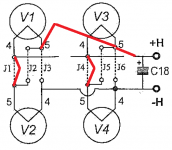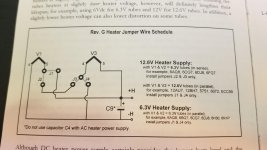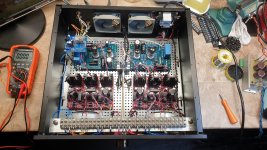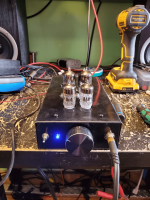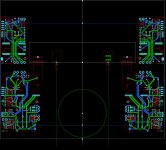Why not run each pair of ECC99 12.6v filaments in series? (25.2v)
How do I do that with all that wired in the boards already?
Here is the manual schem that came with these mono 9 pin boards. which looks different that your Alashikata. This shows how I can wire in series with jumpers but I am using the Janus Regulator so do I put 25v into the heater circuit on that board?
Attachments
Last edited:
I think John revision manual never 100% complete. Even the last one, he still miss some components where you need to ask him.
Different revision has different jumpers. If you connect pin 5 of V1 to pin 4 of V3, then it's 25v. I haven't done mine yet but all my parts are for 6.3v
Different revision has different jumpers. If you connect pin 5 of V1 to pin 4 of V3, then it's 25v. I haven't done mine yet but all my parts are for 6.3v
Here is the manual schem that came with these mono 9 pin boards. which looks different that your Alashikata. This shows how I can wire in series with jumpers but I am using the Janus Regulator so do I put 25v into the heater circuit on that board?
That won't work for the Janus board. You'll need 5V at 2A for the 5Y3 and either 6.3V at 300mA or 12.6V at 150mA for the 7247. Small 12.6 transformers are very common.
I ran into a problem using a Janus reg board for a preamp when I lived in a place where there were big jumps in the line voltage. The Janus reg doesn't regulate the DC voltage level, and these fluctuations were appearing at the output of the preamp, entering the power amp, making their way through that circuit and affecting the bias of the power tubes. I switched to a series reg (maida) and that solved it.
Hello,
I see this thread has no more new posts, but I try the same to post here my experience with Aikido.
I built a dual mono Noval Aikido with 2 PS21 boards. This is my second Aikido, I used 6CG7 and 6H30 tubes. The last version uses all 6H30, which I prefer.
Its sound was good, but the full orchestra passages were non so focused. So I decided to remove the circuitry supposed to null the noise on the +B rail. Immediately the sound improved, achieving was I was expecting. No bad effects, the noise from the power supply did not increase (the pre remained silent) because the PS21 is a good well-filtered power supply. The grid of the lower right tube is now grounded with the already existing 470Ohm resistor.
The circuitry (2R, 1C) supposed to null the power supply noise does not work at all if the power supply is a very good one, with no or negligible noise on the rails. But for sure, the same circuitry gets the residual audio signal always present on the power rail, and injects it in the signal path, amplifying it according to the gain of the lower right tube. This is not negligible.
Did any of you guys try this mod?
I see this thread has no more new posts, but I try the same to post here my experience with Aikido.
I built a dual mono Noval Aikido with 2 PS21 boards. This is my second Aikido, I used 6CG7 and 6H30 tubes. The last version uses all 6H30, which I prefer.
Its sound was good, but the full orchestra passages were non so focused. So I decided to remove the circuitry supposed to null the noise on the +B rail. Immediately the sound improved, achieving was I was expecting. No bad effects, the noise from the power supply did not increase (the pre remained silent) because the PS21 is a good well-filtered power supply. The grid of the lower right tube is now grounded with the already existing 470Ohm resistor.
The circuitry (2R, 1C) supposed to null the power supply noise does not work at all if the power supply is a very good one, with no or negligible noise on the rails. But for sure, the same circuitry gets the residual audio signal always present on the power rail, and injects it in the signal path, amplifying it according to the gain of the lower right tube. This is not negligible.
Did any of you guys try this mod?
Attachments
I built my own circuit effectively the Aikido without Aikidoeing. The Aikido feeds PSU noise into the unused triode to null the noise, but it only works for LF 50/60/100/120Hz and does nothing for 50kHz SMPS anyway.
I always looked at it as a half-assed work around for a crap power supply. My philosophy is if the PSU is clean, the PSRR doesn't need to be good.
One of my headphone amps: This one uses 6N3P and 6N6P.


I always looked at it as a half-assed work around for a crap power supply. My philosophy is if the PSU is clean, the PSRR doesn't need to be good.
One of my headphone amps: This one uses 6N3P and 6N6P.
Attachments
Last edited:
Good job on the pictures!
I understand you designed your PCB. Any suggestion about a good PCB Making service? I have the Gerber files almost ready for a project of mine.
You are right about power supplies. A power supply worthy of the name does not need any particular circuitry to rise up the PSRR.
But if you use the Aikido as a headphone amp, you have to use the 2R and 1C in order to activate the push-pull mode on the right totem, and lower the output impedance; you also need to put in place the low-value resistor on the +B rail (R16 in my schematic), which is not decoupled by any capacitor. I do not like at all the idea to obtain the splitting of the phase by getting the signal on a derivation of the power-rail/anode, and injecting it in the lower grid, it is not a simultaneous phase splitter, kind of Paraphase, whose good points are hard for me to understand, with respect to a Long Tail or a Cross-Coupled or a Cathodyne.
If you want the headphone to be driven by the Aikido (that necessarily implies a push-pull working mode), IMHO it would be a lot better to activate the "Gomez Mode" without using the 2R, 1C, nand the resistor on the +B rail: simply connect the two lower grids together via their 470Ohm resistors.
I understand you designed your PCB. Any suggestion about a good PCB Making service? I have the Gerber files almost ready for a project of mine.
You are right about power supplies. A power supply worthy of the name does not need any particular circuitry to rise up the PSRR.
But if you use the Aikido as a headphone amp, you have to use the 2R and 1C in order to activate the push-pull mode on the right totem, and lower the output impedance; you also need to put in place the low-value resistor on the +B rail (R16 in my schematic), which is not decoupled by any capacitor. I do not like at all the idea to obtain the splitting of the phase by getting the signal on a derivation of the power-rail/anode, and injecting it in the lower grid, it is not a simultaneous phase splitter, kind of Paraphase, whose good points are hard for me to understand, with respect to a Long Tail or a Cross-Coupled or a Cathodyne.
If you want the headphone to be driven by the Aikido (that necessarily implies a push-pull working mode), IMHO it would be a lot better to activate the "Gomez Mode" without using the 2R, 1C, nand the resistor on the +B rail: simply connect the two lower grids together via their 470Ohm resistors.
EasyEDA and JLCPCB. And right now, they have a promo that if you make the thing in EasyEDA and use that to send it to JLC, they give you an 8$ coupon.
My last order I got 10 boards shipped for 3.10$CAD
My "actively loaded triode amplifier" negates the 2R1C in favour is SE output. It will drive 32R loud enough. It drives 470R very well, and of course, it also drives the input of 10 power amplifiers in parallel, 9 tube, 1 SS. So (9x100k) || 10k == about 5k

My last order I got 10 boards shipped for 3.10$CAD
My "actively loaded triode amplifier" negates the 2R1C in favour is SE output. It will drive 32R loud enough. It drives 470R very well, and of course, it also drives the input of 10 power amplifiers in parallel, 9 tube, 1 SS. So (9x100k) || 10k == about 5k
Thank you for the clues about the PCB services. I have already the Gerber files almost ready, I work with Sprint Layout 6.0. So I won't get any discount. Perhaps If I use EasyEDA and import the Gerber files into it, it will work and give me the discount. I'll try. I really don't like to design PCBs so I usually take a long time, then I need to forget about the tracks for some days, and then open again the CAD and check with the schematic if the drawing is correct. This time I had to design two reversible boards, which can be used symmetrically for the L and R channels. Take a look, the picture does not show the bottom side serigraphy. This project pushes the single-ended sound to a superior level.
My first Aikido had 4x 6H30 fed with 320V.
I tried to stress it and the result was a strong desymmetrization of the sine wave with a swing of 200VP-P into a resistive load of 1KOhm. Transforming it in Gomez, the dissymmetry disappeared. This was a test that never happens in real use, but for sure the output impedance in PP Gomez mode is a lot lower. However, I didn't try to hear the Gomez mod with a music signal because I was not interested in driving a headphone.
So I restored the original SE circuitry, lowered the voltage to 300V, and replaced the 6H30s (one was defective) with the 6CG7s. This Aikido build is still working in this way. Since my goal was to polarize the heathers slightly positively with respect to their corresponding cathodes (as they are supposed to be), I drew my PCB using the triodes coupled horizontally in the same tube, instead of vertically, as the original PCBs do. Obviously, I used two different power supplies for the heathers.
In my main audio system, I have the second Aikido equipped with all 6H30s fed with 250V. I used the original mono PCBs, which couple the triodes vertically.
Now, in order to have two comparable Aikidos, I would like to operate on the first one and replace the 6CG7s with 6H30s, remove the 2R1C, lower the voltage to 250V and try to hear any difference between the different polarization of the heathers. I only need the time to do it, and a vacation of my wife to Italy.
By now what I can say, being today the 2nd day, the removal of the 2R1C improves the sound for sure.
I recommend you connect a 470KOhm resistor between the center of the potentiometer and the ground, in order to ensure the polarization to the grid of the first diode always, even when the potentiometer becomes dirty.
My first Aikido had 4x 6H30 fed with 320V.
I tried to stress it and the result was a strong desymmetrization of the sine wave with a swing of 200VP-P into a resistive load of 1KOhm. Transforming it in Gomez, the dissymmetry disappeared. This was a test that never happens in real use, but for sure the output impedance in PP Gomez mode is a lot lower. However, I didn't try to hear the Gomez mod with a music signal because I was not interested in driving a headphone.
So I restored the original SE circuitry, lowered the voltage to 300V, and replaced the 6H30s (one was defective) with the 6CG7s. This Aikido build is still working in this way. Since my goal was to polarize the heathers slightly positively with respect to their corresponding cathodes (as they are supposed to be), I drew my PCB using the triodes coupled horizontally in the same tube, instead of vertically, as the original PCBs do. Obviously, I used two different power supplies for the heathers.
In my main audio system, I have the second Aikido equipped with all 6H30s fed with 250V. I used the original mono PCBs, which couple the triodes vertically.
Now, in order to have two comparable Aikidos, I would like to operate on the first one and replace the 6CG7s with 6H30s, remove the 2R1C, lower the voltage to 250V and try to hear any difference between the different polarization of the heathers. I only need the time to do it, and a vacation of my wife to Italy.
By now what I can say, being today the 2nd day, the removal of the 2R1C improves the sound for sure.
I recommend you connect a 470KOhm resistor between the center of the potentiometer and the ground, in order to ensure the polarization to the grid of the first diode always, even when the potentiometer becomes dirty.
Attachments
kodabmx: is it 3.10$CAD included everything? I did the same thing and submitted the payment but they kept end up 11.xx something extra to total around $16.xx U.S. I tried two times and it was the same even though I chose the the cheapest shipping. Btw, 220uf/450v is better than 50uF or 150uf? The latest version using 50uF poly without problem.
marigno: Does your chassis is steel? I got a bad hum with steel chassis until I changed to aluminum, death silence.
- Home
- Amplifiers
- Tubes / Valves
- Building a Aikido preamplifier
